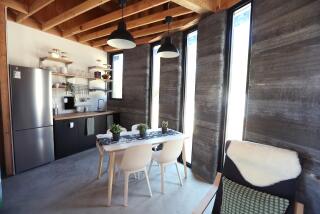North Carolina team’s solar house: surprise in the concrete walls
- Share via
For Solar Decathlon 2013, we put a virtual microphone in front of some teams and let the competitors explain their home design, in their own words. First up: the University of North Carolina at Charlotte, which like the 19 other teams in the Department of Energy competition, is racing to finish construction by Wednesday, so it could open to the public Tuesday at the Orange County Great Park. Team leader Clarke Snell, a master’s student in architecture, explained why the UNC Charlotte house has walls made of geopolymer concrete with “capillary tubes” and why the team had to play a little catch-up in Irvine.
Question: We hear your team was one of several that had problems getting house modules trucked to the site. What happened?
Since our house is steel and concrete it is very heavy, some of our state permits took longer than expected and it delayed us one day.
When did your modules arrive at the Great Park?
Our living room module arrived Monday morning [Sept. 23], Day 1. The kitchen, mechanical core and bedroom modules were delayed and did not arrive until Tuesday night and Wednesday afternoon. So instead of having our large crane set the pods on Tuesday, we had to delay a day until Wednesday.
What have been the biggest challenges in constructing the house? Will the team have to do anything different to make up for lost time?
The biggest challenge was definitely losing a day because of the trucking permit delay. Since we only have 10 days, every hour counts. We have a very dedicated team and everyone is now working 7 a.m. to 2 a.m. to finish on time.
GALLERY: UNC Charlotte’s UrbanEden in pictures
It’s my understanding your house uses a geopolymer cement concrete that reduces the carbon footprint. How is the material different?
Created at UNC Charlotte, geopolymer concrete reduces carbon emissions two ways. Traditional portland cement is responsible for at least 7% of our worldwide carbon footprint because it requires burning limestone and gives off CO2 when curing. Our geopolymer reuses a waste product from coal production, fly ash, to create the cement, and when curing, the geopolymer does not give off CO2. Geopolymer cement reduces carbon emissions from concrete by 90%, which is huge!
Can you explain how the house heats and cools itself? There are tubes circulating water through the pre-cast concrete walls?
The capillary tube system: To start, the house has a stable temperature because of its large concrete mass, which stores large quantities of thermal energy. We run water through the capillary tubes in the wall; at night, that water goes into our rooftop heat exchangers, which release the heat to the night sky and return cool water to the walls. In addition, high-performance mini-split heat pumps provide the homeowner the ability to quickly adjust the temperature when desired.
FULL COVERAGE: Solar Decathlon 2013
From you’ve seen so far, who is your toughest competition? What other houses are you most curious to experience when construction is finished?
Every house is so different, it blows my mind. And since we arrived, everyone has been so cooperative -- loaning tools and sharing scaffolding. It is a phenomenal atmosphere here, and I want to see all the houses perform well.
As told to Craig Nakano. Twitter: @cnakanoJOIN THE CONVERSATION:@latimeshome | pinterest.com/latimeshome | facebook.com/latimeshome | facebook.com/latimesgarden
More to Read
Inside the business of entertainment
The Wide Shot brings you news, analysis and insights on everything from streaming wars to production — and what it all means for the future.
You may occasionally receive promotional content from the Los Angeles Times.










